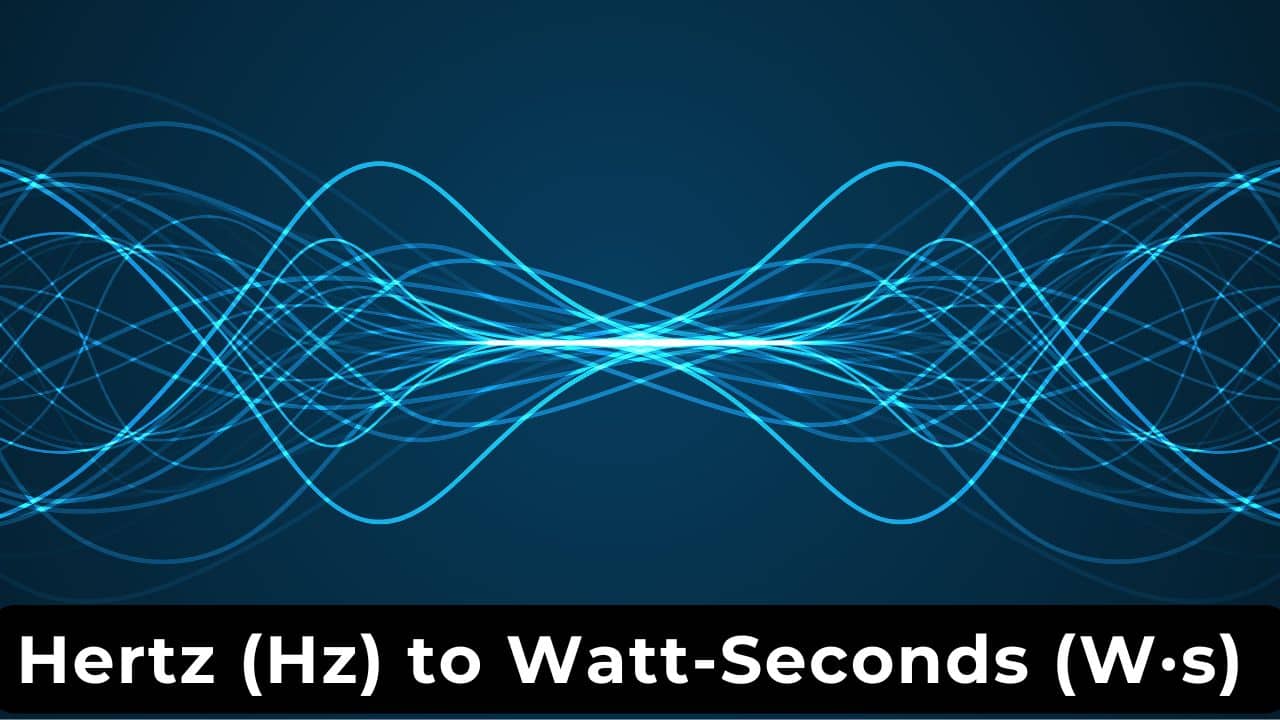
Hertz ↔ Watt-Second Conversion: Photon Energy Guide
Let’s explore the fascinating relationship between frequency and energy in the quantum world!
What is Frequency? (Hertz – Hz)
Frequency tells us how many complete waves or cycles pass through a point in exactly one second.
Definition: 1 Hertz (1 Hz) means one complete wave cycle occurs every second.
Real-World Examples:
- Radio Waves: FM radio operates at 88-108 MHz (million Hz)
- Visible Light: Red light ≈ 4.3 × 10¹⁴ Hz, Blue light ≈ 6.4 × 10¹⁴ Hz
- X-rays: Medical X-rays ≈ 3 × 10¹⁸ Hz
- WiFi Signals: 2.4 GHz and 5 GHz (billion Hz)
- Microwaves: Microwave ovens use 2.45 GHz
What is Energy? (Watt-Second – W·s)
Watt-second (W·s) is a unit of energy, exactly equal to one Joule (J). It measures how much energy a photon carries.
Key Concept: Every photon of electromagnetic radiation carries a specific amount of energy that depends on its frequency.
Understanding Photon Energy:
Higher frequency = Higher energy photons
- Radio waves: Very low frequency → Very low energy
- Visible light: Medium frequency → Medium energy
- X-rays: High frequency → High energy
- Gamma rays: Extremely high frequency → Extremely high energy
Energy Scale Examples:
- Radio Photon: ~10⁻²⁸ J (extremely tiny energy)
- Red Light Photon: ~3.1 × 10⁻¹⁹ J
- Blue Light Photon: ~4.6 × 10⁻¹⁹ J
- UV Light Photon: ~10⁻¹⁸ J (can cause sunburn)
- X-ray Photon: ~10⁻¹⁵ J (penetrates soft tissue)
The Planck Connection: E = h × f
The relationship between frequency and energy was discovered by Max Planck in 1900, revolutionizing physics and launching quantum mechanics!
Planck’s Energy Equation:
E = h × f
f = E ÷ h
What Each Symbol Means:
- E = Energy of one photon (in Joules or W·s)
- h = Planck’s constant = 6.62607015 × 10⁻³⁴ J·s
- f = Frequency of the electromagnetic wave (in Hz)
Why This Formula Works:
- Light behaves as both waves and particles (wave-particle duality)
- Each “packet” of light is called a photon
- Higher frequency waves have more energetic photons
- Planck’s constant is the “exchange rate” between frequency and energy
- This formula applies to ALL electromagnetic radiation!
Why This Conversion Matters
Solar Energy
Solar panels convert photon energy to electricity. Engineers need to know the energy content of different wavelengths to optimize efficiency.
Medical Physics
X-ray and radiation therapy require precise energy calculations to deliver correct doses while minimizing tissue damage.
Spectroscopy
Scientists identify materials by measuring the specific frequencies (and energies) of light they absorb or emit.
Quantum Electronics
LED lights, lasers, and photodetectors all depend on the precise relationship between photon frequency and energy.
Practice Problems for Students
Problem 1: Red Light Photon
Question: Red light has a frequency of 4.3 × 10¹⁴ Hz. What is the energy of one red photon?
Click to see solution
Solution: E = h × f = (6.626 × 10⁻³⁴) × (4.3 × 10¹⁴) = 2.85 × 10⁻¹⁹ J
Explanation: This tiny energy is what makes red light “red” to our eyes!
Problem 2: X-ray Energy
Question: A medical X-ray photon has energy of 3.2 × 10⁻¹⁵ J. What is its frequency?
Click to see solution
Solution: f = E ÷ h = (3.2 × 10⁻¹⁵) ÷ (6.626 × 10⁻³⁴) = 4.83 × 10¹⁸ Hz
Explanation: This extremely high frequency allows X-rays to penetrate soft tissue.
Problem 3: Blue vs Red Light
Question: Blue light (6.4 × 10¹⁴ Hz) vs Red light (4.3 × 10¹⁴ Hz). How much more energy does blue light have?
Click to see solution
Blue: E = (6.626 × 10⁻³⁴) × (6.4 × 10¹⁴) = 4.24 × 10⁻¹⁹ J
Red: E = (6.626 × 10⁻³⁴) × (4.3 × 10¹⁴) = 2.85 × 10⁻¹⁹ J
Ratio: 4.24/2.85 = 1.49 times more energy!
Electromagnetic Spectrum Reference
Common Electromagnetic Radiation:
| Type | Frequency (Hz) | Photon Energy (J) | Applications |
|---|---|---|---|
| Radio Waves | 10⁶ Hz | 6.6 × 10⁻²⁸ J | Communication |
| Microwaves | 10¹⁰ Hz | 6.6 × 10⁻²⁴ J | Heating, Radar |
| Infrared | 10¹³ Hz | 6.6 × 10⁻²¹ J | Heat sensors |
| Visible Light | 5 × 10¹⁴ Hz | 3.3 × 10⁻¹⁹ J | Vision, Solar |
| UV Light | 10¹⁶ Hz | 6.6 × 10⁻¹⁸ J | Sterilization |
| X-rays | 10¹⁸ Hz | 6.6 × 10⁻¹⁶ J | Medical imaging |
